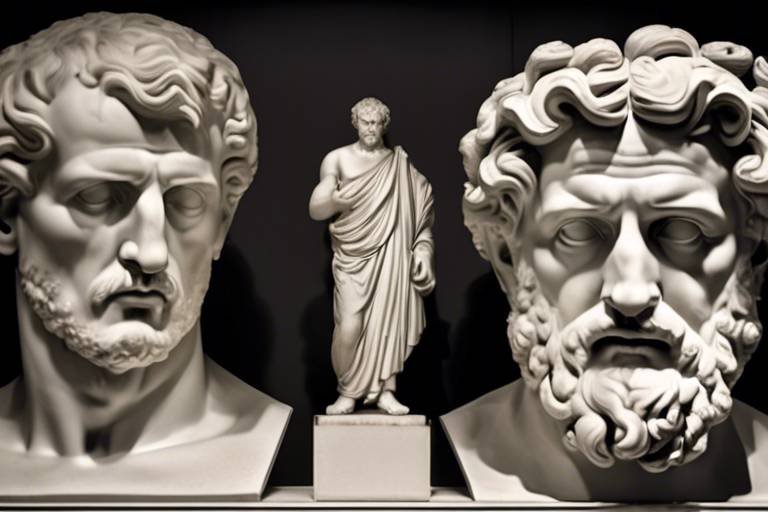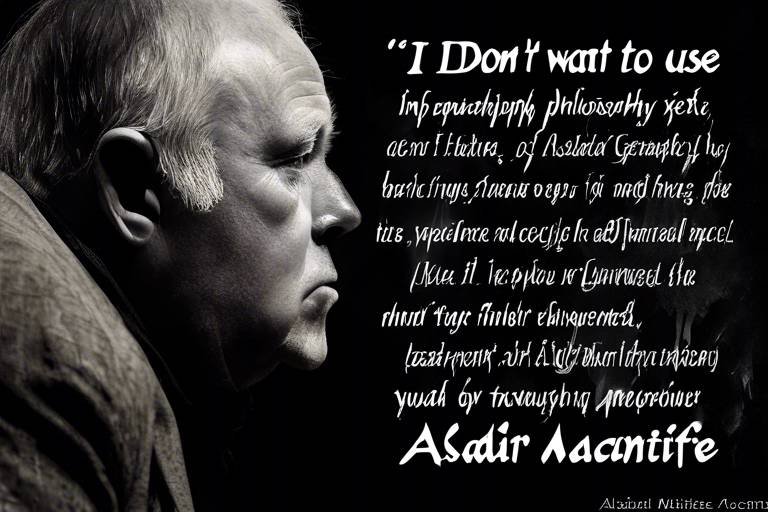Analyzing Stoicism and Its Key Concepts
Stoicism, a philosophy that has stood the test of time, invites us to explore the depths of our emotions and the nature of our existence. Founded in ancient Greece, this school of thought encourages individuals to pursue virtue and wisdom as guiding principles in life. At its core, Stoicism teaches us to differentiate between what we can control and what we cannot, fostering a sense of emotional resilience that is crucial in today’s fast-paced world. As we delve into the essence of Stoicism, we will uncover how its teachings can be applied to modern life, offering tools for personal growth and emotional stability.
The historical context of Stoicism is rich and fascinating, tracing back to its founders, such as Zeno of Citium, who first articulated these ideas around 300 BCE. As we journey through the ages, we find that Stoicism has influenced a plethora of remarkable individuals, from Roman emperors like Marcus Aurelius to modern thinkers and leaders. Each of these figures embraced Stoic principles, applying them to navigate the complexities of their lives, and in doing so, they left behind a legacy that continues to inspire countless people today.
But what exactly are the key concepts that define Stoicism? At its foundation lies the idea that virtue is the highest good. This notion propels us to strive for a life characterized by moral excellence and rational thought. The Stoics believed that true happiness is not found in external circumstances but rather in the cultivation of one's character and the alignment of one's actions with nature. This leads us to the critical understanding of living in accordance with nature, which encourages acceptance of the world as it is and finding peace within that acceptance.
As we dissect the core principles of Stoicism, we can identify the four cardinal virtues that serve as pillars of this philosophy: wisdom, courage, justice, and temperance. Each virtue plays a vital role in shaping our moral compass and guiding our decisions. For instance, wisdom enables us to discern what is truly important, courage helps us face challenges head-on, justice ensures fairness in our interactions, and temperance teaches us moderation in all things.
In a world filled with uncertainty and chaos, Stoicism offers a beacon of hope. By focusing on what we can control—our thoughts, actions, and reactions—we can cultivate a profound sense of emotional resilience. This practice is not merely theoretical; it has practical applications that can transform our daily lives. Imagine facing a stressful situation with a calm mind, knowing that your response is within your control while external events are not. This mindset shift can lead to greater peace and satisfaction.
As we explore the practical applications of Stoicism today, we will uncover techniques that can be seamlessly integrated into our routines. From negative visualization—the practice of contemplating potential losses to appreciate what we have—to journaling for self-reflection, these methods empower us to embody Stoic principles in our everyday lives. Furthermore, the relevance of Stoicism extends beyond personal development; it can also be a powerful tool in leadership and business. Leaders who adopt a Stoic mindset are better equipped to make rational decisions, maintain composure under pressure, and inspire resilience in their teams.
In conclusion, Stoicism is more than just an ancient philosophy; it is a way of life that encourages us to confront reality with courage and grace. As we continue to dissect its teachings, we will find that the wisdom of the Stoics is not only applicable but essential in navigating the complexities of modern existence. So, are you ready to embrace the Stoic way and transform your perspective on life?
- What is Stoicism? - Stoicism is an ancient Greek philosophy that teaches the development of self-control and fortitude as a means of overcoming destructive emotions.
- Who are the main figures in Stoicism? - Key figures include Zeno of Citium, Seneca, Epictetus, and Marcus Aurelius.
- How can I practice Stoicism in daily life? - You can practice Stoicism through techniques like negative visualization, journaling, and focusing on what you can control.
- Is Stoicism relevant today? - Absolutely! Stoicism offers valuable insights for emotional resilience and decision-making in our modern, fast-paced world.

The Origins of Stoicism
To truly grasp the essence of Stoicism, it’s essential to delve into its rich historical tapestry. This ancient philosophy was born in Athens around the early 3rd century BCE, founded by Zeno of Citium. Zeno was a merchant who, after surviving a shipwreck, found himself drawn to philosophy. He began studying under the Cynics and other philosophical schools, ultimately developing his own ideas that would lay the groundwork for Stoicism.
As Zeno began teaching in the Stoa Poikile, or the "Painted Porch," in Athens, he attracted a diverse group of followers. This gathering of minds included notable figures such as Cleanthes, who succeeded Zeno as the head of the school, and Chrysippus, who is often credited with systematizing Stoic thought and expanding its reach. The teachings of these early Stoics emphasized the importance of virtue and living in accordance with reason, which they believed was the path to true happiness.
Over the centuries, Stoicism evolved and adapted through various historical contexts. The Roman period marked a significant chapter in Stoic history, with prominent figures like Seneca, Epithetus, and the Roman Emperor Marcus Aurelius championing its principles. Each of these Stoics brought their unique perspectives, enriching the philosophy with practical insights on dealing with life's adversities. For instance, Marcus Aurelius, in his Meditations, offers a personal glimpse into how he applied Stoic principles to govern himself and his empire, making it relatable and applicable to daily life.
As we explore the historical lineage of Stoicism, it’s fascinating to note how its core ideas have transcended time and geographical boundaries. The philosophy not only influenced Roman thinkers but also found resonance in the works of early Christian theologians, who integrated Stoic ethics into their teachings. This cross-pollination of ideas helped Stoicism endure through the ages, allowing it to be rediscovered during the Renaissance and continue to inspire modern thinkers.
In summary, the origins of Stoicism are deeply rooted in the quest for understanding the human condition and the pursuit of a virtuous life. Its founders laid a strong foundation that has been built upon by countless philosophers and practitioners, making Stoicism a timeless guide for achieving emotional resilience and clarity in an often chaotic world.

Core Principles of Stoicism
At the heart of Stoicism lies a collection of core principles that serve as guiding lights for practitioners navigating the tumultuous waters of life. These principles are not just philosophical musings; they are practical tools designed to foster a sense of purpose and emotional stability. Imagine trying to sail a ship without a compass—how would you know where to go? Stoicism provides that compass, helping individuals steer through challenges with grace and resilience.
One of the most significant tenets of Stoicism is the emphasis on virtue. Stoics believe that virtue is the highest good and the ultimate goal of life. This means that true happiness and fulfillment do not come from external possessions or accolades, but rather from cultivating a strong moral character. Think of virtue as the foundation of a sturdy house; without it, everything else is built on shaky ground. The Stoics defined virtue as living in accordance with reason and nature, which leads to a harmonious existence.
To further dissect the concept of virtue, we can look into the four cardinal virtues that Stoicism champions:
- Wisdom: The ability to discern what is truly important and to make sound judgments.
- Courage: The strength to face fears and challenges head-on.
- Justice: The commitment to fairness and the welfare of others.
- Temperance: The practice of self-control and moderation in all aspects of life.
Each of these virtues plays a crucial role in shaping a Stoic's moral character. They are not just theoretical ideals but practical guidelines that influence decision-making and interpersonal relationships.
Another foundational principle of Stoicism is the idea of living in accordance with nature. This concept encourages individuals to accept the natural order of the universe and align their actions with this understanding. Imagine trying to swim against a strong current; it takes a lot of energy and often leads to exhaustion. However, when you learn to work with the current, you can navigate much more efficiently. By recognizing what is within our control and what is not, we can focus our energy on the things that truly matter.
Stoicism also teaches the importance of rationality. In a world filled with chaos and emotional upheaval, the ability to think clearly and logically is invaluable. Stoics advocate for a rational approach to life, suggesting that our responses to external events should be measured and thoughtful. This does not mean suppressing emotions; rather, it’s about understanding them and choosing how to respond appropriately.
In summary, the core principles of Stoicism—virtue, living in accordance with nature, and rationality—serve as a robust framework for achieving a fulfilling life. By embracing these principles, individuals can cultivate a strong moral character, navigate life's challenges with resilience, and ultimately find peace amidst the chaos. So, the next time you feel overwhelmed, remember that Stoicism offers a treasure trove of wisdom to help you regain your footing.
What is Stoicism?
Stoicism is an ancient Greek philosophy that teaches the development of self-control and fortitude as a means to overcome destructive emotions.
How can I apply Stoicism in my daily life?
You can apply Stoicism by practicing mindfulness, focusing on what you can control, and reflecting on your actions and decisions through journaling.
What are the benefits of practicing Stoicism?
Practicing Stoicism can lead to improved emotional resilience, better decision-making, and a greater sense of inner peace.

Virtue as the Highest Good
In the realm of Stoicism, the concept of virtue stands tall as the ultimate goal of life. But what does it really mean to live a virtuous life? For the Stoics, virtue is not just an abstract idea; it is the very essence of human existence. They believed that true happiness and fulfillment stem from living a life characterized by moral excellence. Imagine virtue as the North Star guiding sailors at sea; it provides direction and purpose, helping individuals navigate the tumultuous waters of life.
So, how do the Stoics define virtue? They view it as a harmonious blend of four cardinal virtues: wisdom, courage, justice, and temperance. Each of these virtues plays a critical role in shaping our character and influencing our decisions. To give you a clearer picture, let’s break down these virtues:
| Virtue | Description |
|---|---|
| Wisdom | The ability to make sound judgments and decisions based on knowledge and understanding. |
| Courage | The strength to confront fear, uncertainty, and challenges with confidence. |
| Justice | The commitment to fairness and treating others with respect and dignity. |
| Temperance | The practice of self-control and moderation in all aspects of life. |
By embodying these virtues, Stoics believe that individuals can cultivate a strong moral character, which is essential for making ethical decisions. Think of it this way: when faced with a challenging situation, a wise person will weigh their options carefully, a courageous individual will act despite their fears, a just person will consider the impact of their actions on others, and a temperate person will avoid excess and maintain balance. Together, these virtues create a solid foundation for a fulfilling life.
Moreover, the Stoics emphasized the importance of living in accordance with nature. This principle advocates for an acceptance of the natural order of the universe and encourages individuals to align their actions with this understanding. It’s about recognizing that while we cannot control external events, we can control our responses to them. By cultivating virtue, we not only enhance our own lives but also contribute positively to the world around us.
In summary, virtue is not merely a lofty ideal in Stoicism; it is the cornerstone of a meaningful existence. By striving towards wisdom, courage, justice, and temperance, we can navigate life’s challenges with grace and resilience. So, the next time you find yourself at a crossroads, remember that the path of virtue is always open to you, guiding you toward a life of purpose and emotional stability.

The Four Cardinal Virtues
The philosophy of Stoicism is deeply rooted in the concept of virtue, which the Stoics believed to be the highest good. This belief is not just a mere abstract idea; it serves as a guiding principle for living a fulfilling life. The Stoics identified four cardinal virtues that are essential for moral character and ethical decision-making: wisdom, courage, justice, and temperance. Each of these virtues plays a critical role in shaping how we interact with ourselves and the world around us.
Wisdom is the ability to discern what is true and valuable. It enables us to navigate life's complexities with clarity and insight. A wise person understands the difference between what is within their control and what is not, allowing them to focus their energy on actions that lead to personal growth. This virtue encourages us to seek knowledge and understanding, reminding us that learning is a lifelong journey.
Courage is not merely the absence of fear but the ability to act rightly in the face of it. Stoics believe that true courage involves standing firm in our principles, even when external pressures try to sway us. It is the strength to confront challenges, whether they are physical, emotional, or moral. By cultivating courage, we empower ourselves to make difficult decisions and embrace the uncertainties of life.
Justice is about fairness and the moral obligation to treat others with respect and integrity. Stoics viewed justice as a cornerstone of a harmonious society. It compels us to act in ways that promote the common good, ensuring that our actions contribute positively to the lives of others. This virtue reminds us that we are interconnected, and our choices have a ripple effect on the broader community.
Temperance is the practice of self-control and moderation. It teaches us to balance our desires and impulses, preventing us from being led astray by fleeting pleasures. A temperate person exercises restraint, understanding that true happiness comes not from indulgence but from a measured approach to life's offerings. This virtue is vital for maintaining emotional stability and achieving long-term goals.
In summary, the four cardinal virtues of Stoicism—wisdom, courage, justice, and temperance—serve as a roadmap for ethical living. By integrating these virtues into our daily lives, we can cultivate a strong moral character and navigate the complexities of existence with grace and resilience. Embracing these principles not only enriches our personal lives but also enhances our interactions with others, creating a more just and harmonious world.
- What are the four cardinal virtues of Stoicism? The four cardinal virtues are wisdom, courage, justice, and temperance.
- How can I apply these virtues in my daily life? You can apply these virtues by making conscious decisions that reflect wisdom, standing firm in your principles with courage, treating others fairly with justice, and practicing self-control with temperance.
- Why are the cardinal virtues important? They provide a framework for ethical behavior and help cultivate emotional resilience and personal growth.
- Can Stoicism help with mental health? Yes, Stoicism teaches acceptance and focusing on what we can control, which can significantly improve mental well-being.

Living in Accordance with Nature
Living in accordance with nature is a cornerstone of Stoic philosophy, emphasizing the importance of understanding and embracing the natural order of the universe. Imagine standing in a river, feeling the water flow around you. You can either fight against the current, exhausting yourself, or you can learn to navigate it, moving with the flow. This metaphor captures the essence of Stoicism's approach to living harmoniously with nature. The Stoics believed that by aligning our actions and thoughts with the natural world, we can achieve a sense of peace and fulfillment that is otherwise elusive.
At its core, this principle teaches us that life is full of events and circumstances beyond our control. The Stoics argue that instead of resisting these external forces, we should accept them as part of the grand design of the universe. This acceptance does not mean passivity; rather, it encourages us to focus on what we can control—our thoughts, reactions, and choices. By doing so, we cultivate resilience and emotional stability, allowing us to respond to life's challenges with grace and composure.
The idea of living in accordance with nature also extends to our relationships and interactions with others. The Stoics emphasized the interconnectedness of all beings, suggesting that our actions should reflect a sense of responsibility towards others. This perspective fosters empathy and compassion, reminding us that we are all part of a larger community. When we act with this awareness, we contribute to the harmony of our environment, creating a positive ripple effect in our lives and the lives of those around us.
Moreover, embracing this Stoic principle encourages us to appreciate the present moment. In a world obsessed with future aspirations and past regrets, the Stoics remind us that true contentment lies in recognizing the beauty of the here and now. Whether it's the warmth of the sun on our skin or the laughter of a loved one, these moments are fleeting yet profoundly significant. By grounding ourselves in the present, we can cultivate gratitude and a deeper appreciation for life itself.
In summary, living in accordance with nature is about more than just acceptance; it’s a call to engage actively with the world around us. It urges us to reflect on our values, prioritize our actions, and recognize our place within the cosmos. By embracing this Stoic principle, we can navigate the complexities of life with a sense of purpose and inner peace, ultimately leading to a more fulfilled existence.
- What does it mean to live in accordance with nature?
Living in accordance with nature means aligning your actions and thoughts with the natural order of the universe, accepting what you cannot control, and focusing on your own responses and choices. - How can I apply the principle of living in accordance with nature in my daily life?
You can apply this principle by practicing acceptance, being mindful of your reactions to external events, and appreciating the present moment. - Why is emotional resilience important in Stoicism?
Emotional resilience is crucial because it enables individuals to maintain inner peace and composure in the face of life's challenges, allowing for a more fulfilling and purposeful life.

Emotional Resilience through Stoicism
Have you ever felt overwhelmed by life's challenges, like you're riding a roller coaster with no brakes? Well, that's where Stoicism can come to your rescue! This ancient philosophy teaches us that while we can't control everything that happens to us, we can control our reactions to those events. Imagine having a shield that protects your emotional well-being; that's the essence of emotional resilience through Stoicism. By focusing on what we can control and accepting what we cannot, we cultivate a profound sense of peace and stability in our lives.
At the heart of Stoic resilience is the understanding that our thoughts shape our reality. Think of it this way: if you were to look at a glass of water, is it half empty or half full? A Stoic would argue that it's neither; it simply is what it is. This perspective allows us to step back from our emotions and view situations with clarity. By practicing this mindset, we can transform our approach to adversity. Instead of feeling defeated by challenges, we can see them as opportunities for growth and learning.
One of the key techniques Stoics employ to build emotional resilience is called negative visualization. This practice involves contemplating potential challenges or losses before they occur. It may sound counterintuitive, but by envisioning what could go wrong, we prepare ourselves mentally and emotionally for whatever life throws our way. For instance, consider how you might react if you lose your job. By thinking through this scenario beforehand, you can develop a plan and a mindset that mitigates panic and anxiety, allowing you to respond with calmness and strength when faced with the actual situation.
Another essential aspect of Stoic resilience is the concept of amor fati, or love of fate. This idea encourages us to embrace everything that happens in our lives, both the good and the bad, as necessary parts of our journey. Instead of resisting or resenting difficult situations, we learn to accept them with grace. This acceptance doesn't mean we become passive; rather, it empowers us to take action where we can while remaining at peace with what we cannot change.
In a world that often feels chaotic and unpredictable, Stoicism offers us a framework for navigating our emotional landscape. By practicing these principles, we can build a robust foundation of emotional resilience that helps us thrive, no matter the circumstances. So, the next time life throws you a curveball, remember the Stoic wisdom: it’s not what happens to you, but how you respond that truly matters.
- What is emotional resilience? Emotional resilience is the ability to adapt to stressful situations and bounce back from adversity. It involves maintaining a positive outlook and coping effectively with challenges.
- How does Stoicism help with emotional resilience? Stoicism teaches individuals to focus on what they can control and accept what they cannot, fostering a mindset that promotes inner peace and emotional stability.
- Can anyone practice Stoicism? Absolutely! Stoicism is accessible to everyone, regardless of background or belief system. Its principles can be applied to daily life for improved mental well-being.

Practical Applications of Stoicism Today
In today's fast-paced world, the ancient philosophy of Stoicism has found a new lease on life. Many individuals, from busy professionals to students, are turning to Stoic teachings as a way to navigate the complexities of modern existence. You might be wondering, how can a philosophy that originated over two thousand years ago still hold relevance today? The answer lies in its core principles, which provide practical tools to manage stress, enhance emotional resilience, and foster a sense of purpose.
One of the most appealing aspects of Stoicism is its focus on what we can control. In a world where uncertainty reigns supreme, Stoics teach us to concentrate our efforts on our own thoughts, actions, and reactions. This shift in perspective can be incredibly liberating. Imagine you're caught in traffic, and instead of succumbing to frustration, you remind yourself that the situation is beyond your control. By accepting this, you can maintain your peace of mind and even use the time to listen to an inspiring podcast or reflect on your day.
Another practical application of Stoicism is the practice of negative visualization. This technique involves imagining the loss of what we cherish, whether it be our job, loved ones, or health. While it may sound morbid, this exercise serves to enhance our appreciation for what we have. By contemplating the worst-case scenarios, we can cultivate gratitude and reduce our anxiety about losing these elements in our lives. It’s like giving yourself a little wake-up call to cherish the present moment.
Journaling is another powerful Stoic technique that has gained popularity in recent years. By writing down our thoughts and reflecting on our daily experiences, we can gain clarity and insight into our emotions. A simple practice could involve asking yourself a few questions each evening, such as: “What did I do well today?” or “What could I have handled differently?” This self-reflection not only fosters personal growth but also aligns with the Stoic emphasis on continuous improvement.
Moreover, Stoicism has found its way into the realms of leadership and business. Leaders who embrace Stoic principles often exhibit greater resilience and clarity in decision-making. They understand that challenges are inevitable, but by maintaining a calm demeanor and focusing on solutions, they can inspire their teams to do the same. In fact, many successful entrepreneurs attribute their achievements to a Stoic mindset, which allows them to weather the storms of business with grace and determination.
To illustrate the practical applications of Stoicism, consider the following table that summarizes key techniques and their benefits:
| Technique | Description | Benefits |
|---|---|---|
| Negative Visualization | Imagining the loss of what we cherish. | Enhances gratitude and reduces anxiety. |
| Journaling | Reflecting on daily experiences and emotions. | Promotes self-awareness and personal growth. |
| Focus on Control | Concentrating on what we can control. | Reduces stress and increases inner peace. |
| Mindful Decision-Making | Approaching challenges with a calm mindset. | Improves resilience and inspires others. |
As we can see, the teachings of Stoicism provide us with a toolkit for dealing with the ups and downs of life. Whether you’re looking to improve your mental health or enhance your effectiveness in the workplace, embracing Stoic principles can lead to profound changes. So, why not give it a try? Start small by incorporating one or two Stoic techniques into your daily routine, and watch as your perspective shifts and your resilience grows.
- What is Stoicism? Stoicism is an ancient Greek philosophy that teaches the development of self-control and fortitude as a means to overcome destructive emotions.
- How can I practice Stoicism in my daily life? You can practice Stoicism by focusing on what you can control, engaging in negative visualization, and keeping a journal to reflect on your thoughts and actions.
- Is Stoicism relevant today? Yes, Stoicism is highly relevant today, as it offers practical tools for managing stress and improving emotional well-being in a complex world.

Stoic Techniques for Daily Life
Integrating Stoic principles into our daily routines can feel like discovering a hidden treasure map that leads to emotional wellness and resilience. Imagine waking up each day with a clear mind and a strong sense of purpose. This is the promise of Stoicism! By embracing its techniques, we can navigate the chaos of modern life with grace and composure. One of the most powerful techniques is negative visualization. This practice encourages us to contemplate the potential loss of the things we cherish, whether it’s our loved ones, our jobs, or even our health. While it may sound gloomy, this technique actually fosters gratitude and appreciation for what we have. It’s like shining a light on the positives by acknowledging the negatives, helping us to become more resilient in the face of adversity.
Another effective Stoic technique is journaling. Think of journaling as a personal dialogue with yourself, a way to process your thoughts and emotions. By writing down your feelings and reflecting on your day, you create a space for self-examination and growth. This practice can help you identify your triggers, understand your reactions, and develop a more rational perspective on life’s challenges. You might even find it beneficial to ask yourself a few key questions in your journal each evening, such as: “What did I do well today?” and “What could I have done differently?” This reflection helps cultivate a mindset geared towards continuous improvement.
Additionally, Stoics emphasize the importance of distinguishing between what we can control and what we cannot. This simple yet profound concept can be life-changing. By focusing our energy on actions and responses that are within our control—like our thoughts, attitudes, and behaviors—we free ourselves from the burden of worrying about external circumstances that are beyond our influence. Imagine how liberating it feels to let go of the need to control everything around you! This shift in perspective allows us to approach challenges with a calm and rational mindset, fostering emotional resilience.
Finally, practicing mindfulness can significantly enhance our Stoic journey. Being present in the moment allows us to fully experience life without being overwhelmed by regrets about the past or anxieties about the future. Mindfulness helps us to observe our thoughts and feelings without judgment, enabling us to respond to situations thoughtfully rather than react impulsively. It’s a bit like watching clouds drift by in the sky; we can acknowledge them without letting them dictate our emotional weather.
In summary, by incorporating these Stoic techniques into our daily lives, we can cultivate a profound sense of emotional stability and resilience. Whether through negative visualization, journaling, focusing on what we can control, or practicing mindfulness, these methods empower us to face life's uncertainties with confidence and grace. So why not take a moment today to reflect on how you might weave these practices into your own life? You might just find that the path to emotional well-being is clearer than you ever imagined.
- What is negative visualization? Negative visualization is a Stoic practice of contemplating potential losses to cultivate gratitude and appreciation for what we have.
- How can journaling help with Stoicism? Journaling allows for self-reflection and helps identify triggers, fostering a rational perspective on challenges.
- What does it mean to focus on what we can control? It means directing our energy towards our thoughts and actions, rather than worrying about external factors beyond our control.
- How does mindfulness relate to Stoicism? Mindfulness encourages present-moment awareness, helping us respond thoughtfully rather than react impulsively to life's challenges.

Stoicism in Leadership and Business
When it comes to leadership and business, the teachings of Stoicism offer a refreshing perspective that can transform how we approach challenges and decision-making. In a world where chaos often reigns supreme, Stoicism provides a stable framework that empowers leaders to remain calm, collected, and focused on what truly matters. Imagine being in the midst of a storm, yet feeling an unwavering sense of peace within; that's the essence of a Stoic leader.
At its core, Stoicism teaches us to differentiate between what we can control and what we cannot. This principle is particularly valuable in business, where external factors can often seem overwhelming. For example, market fluctuations, competition, and unforeseen crises are all outside our control. However, by adopting a Stoic mindset, leaders can focus their energy on their responses and actions, rather than becoming consumed by anxiety over uncontrollable events. This shift in perspective not only fosters resilience but also inspires confidence in their teams.
Furthermore, Stoicism encourages a commitment to integrity and ethical decision-making. In the fast-paced business environment, it's easy to get swept away by the allure of quick gains or shortcuts. However, Stoic leaders understand that true success is rooted in virtue and character. By prioritizing ethical considerations, they cultivate a culture of trust and respect within their organizations. This not only enhances employee morale but also builds a loyal customer base that values transparency and integrity.
To illustrate the practical application of Stoicism in leadership, consider the following key Stoic principles:
- Emotional Control: Stoic leaders maintain composure in high-pressure situations, allowing them to think clearly and make rational decisions.
- Long-Term Vision: They focus on long-term goals rather than short-term wins, ensuring sustainable growth and development.
- Self-Reflection: Regular self-assessment helps leaders identify areas for improvement and align their actions with their values.
Moreover, Stoicism can be a powerful tool for fostering a resilient workplace culture. By encouraging team members to embrace challenges as opportunities for growth, leaders can create an environment where innovation thrives. When employees learn to view setbacks through a Stoic lens, they are more likely to take calculated risks and pursue creative solutions without the fear of failure holding them back.
In practical terms, implementing Stoic principles in business might look like this:
| Stoic Principle | Business Application |
|---|---|
| Focus on What You Can Control | Encouraging teams to concentrate on their efforts and responses rather than external pressures. |
| Practice Gratitude | Fostering a positive workplace by recognizing and appreciating team contributions. |
| Accepting Adversity | Training employees to view challenges as learning experiences rather than insurmountable obstacles. |
In conclusion, the integration of Stoicism into leadership and business practices is not just a theoretical exercise; it's a practical approach that can lead to greater resilience, ethical integrity, and long-term success. By embodying Stoic principles, leaders can navigate the complexities of the business world with a sense of purpose and clarity, ultimately fostering a thriving organizational culture.
1. How can Stoicism improve my leadership skills?
Stoicism enhances leadership by promoting emotional control, ethical decision-making, and a long-term vision, allowing leaders to navigate challenges with confidence and integrity.
2. Can Stoic principles be applied in team settings?
Absolutely! Stoic principles encourage teamwork by fostering resilience and a growth mindset, helping teams to view challenges as opportunities for collaboration and innovation.
3. Is Stoicism relevant in today’s business environment?
Yes, Stoicism is highly relevant today as it provides timeless strategies for managing stress, making ethical decisions, and cultivating a positive workplace culture in an ever-changing business landscape.
Frequently Asked Questions
- What is Stoicism?
Stoicism is an ancient Greek philosophy that teaches the development of self-control and fortitude as a means to overcome destructive emotions. It emphasizes rationality, virtue, and living in harmony with nature, guiding individuals towards a fulfilling and meaningful life.
- Who were the key figures in the development of Stoicism?
The philosophy was founded by Zeno of Citium in the early 3rd century BC. Prominent Stoic philosophers include Seneca, Epictetus, and Marcus Aurelius, each contributing significantly to the evolution and understanding of Stoic thought.
- What are the core principles of Stoicism?
The core principles include virtue as the highest good, wisdom, courage, justice, and temperance. Stoics believe that by cultivating these virtues, individuals can achieve true happiness and emotional stability.
- How does Stoicism define virtue?
In Stoicism, virtue is seen as the ultimate goal of life. It encompasses moral character and ethical behavior, guiding individuals to make decisions that align with their values and promote overall well-being.
- What are the Four Cardinal Virtues in Stoicism?
The Four Cardinal Virtues are wisdom, courage, justice, and temperance. Each of these virtues plays a vital role in helping individuals navigate life's challenges and make ethical choices.
- What does it mean to live in accordance with nature?
Living in accordance with nature means accepting the natural order of the universe and aligning one's actions with this understanding. It encourages individuals to embrace life as it is and focus on what they can control.
- How can Stoicism help with emotional resilience?
Stoicism teaches that by focusing on what we can control and accepting what we cannot, we can cultivate emotional resilience. This mindset helps maintain inner peace and stability during challenging times.
- What are some practical applications of Stoicism today?
Modern practitioners use Stoicism to manage stress, improve mental health, and enhance overall well-being. Techniques like negative visualization and journaling are popular ways to incorporate Stoic principles into daily life.
- How can Stoicism be applied in leadership and business?
Stoic principles can enhance decision-making and resilience in the workplace. By adopting a Stoic mindset, leaders can navigate challenges with clarity and composure, fostering a positive work environment.



















